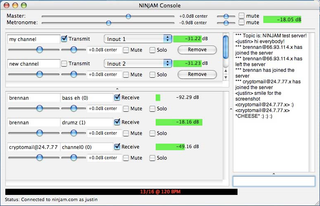
BitchX is a free IRC client that has been regarded as the most popular ircII-based IRC client. The initial implementation, written by "Trench" and "HappyCrappy", was a script for the IrcII chat client. It was converted to a program in its own right by panasync. BitchX 1.1 final was released in 2004. It is written in C and is a TUI application utilizing ncurses. GTK+ toolkit support has been dropped. It works on all Unix-like operating systems, and is distributed under a BSD license. It was originally based on ircII-EPIC, and eventually it was merged into the EPIC IRC client. It supports IPv6, multiple servers and SSL, and a subset of UTF-8 with an unofficial patch.
The Invisible Internet Project (I2P) is an anonymous network layer that allows for censorship-resistant, peer-to-peer communication. Anonymous connections are achieved by encrypting the user's traffic, and sending it through a volunteer-run network of roughly 55,000 computers distributed around the world. Given the high number of possible paths the traffic can transit, a third party watching a full connection is unlikely. The software that implements this layer is called an "I2P router", and a computer running I2P is called an "I2P node". I2P is free and open sourced, and is published under multiple licenses.
OpenVPN is a virtual private network (VPN) system that implements techniques to create secure point-to-point or site-to-site connections in routed or bridged configurations and remote access facilities. It implements both client and server applications.

Git is a distributed version control system that tracks changes in any set of computer files, usually used for coordinating work among programmers who are collaboratively developing source code during software development. Its goals include speed, data integrity, and support for distributed, non-linear workflows.
Music Player Daemon (MPD) is a free and open source music player server. It plays audio files, organizes playlists and maintains a music database. In order to interact with it, a client program is needed. The MPD distribution includes mpc, a simple command line client.

NINJAM stands for Novel Intervallic Network Jamming Architecture for Music. The software and systems comprising NINJAM provide a non-realtime mechanism for exchanging audio data across the internet, with a synchronisation mechanism based on musical form. It provides a way for musicians to "jam" (improvise) together over the Internet; it pioneered the concept of "virtual-time" jamming. It was originally developed by Brennan Underwood, Justin Frankel, and Tom Pepper.
Capacity management's goal is to ensure that information technology resources are sufficient to meet upcoming business requirements cost-effectively. One common interpretation of capacity management is described in the ITIL framework. ITIL version 3 views capacity management as comprising three sub-processes: business capacity management, service capacity management, and component capacity management.
Latency refers to a short period of delay between when an audio signal enters a system and when it emerges. Potential contributors to latency in an audio system include analog-to-digital conversion, buffering, digital signal processing, transmission time, digital-to-analog conversion and the speed of sound in the transmission medium.
This is a comparison of notable free and open-source configuration management software, suitable for tasks like server configuration, orchestration and infrastructure as code typically performed by a system administrator.

Mumble is a voice over IP (VoIP) application primarily designed for use by gamers and is similar to programs such as TeamSpeak.

Jami is a SIP-compatible distributed peer-to-peer softphone and SIP-based instant messenger for Linux, Microsoft Windows, macOS, iOS, and Android. Jami was developed and maintained by the Canadian company Savoir-faire Linux, and with the help of a global community of users and contributors, Jami positions itself as a potential free Skype replacement.
HTTP Live Streaming is an HTTP-based adaptive bitrate streaming communications protocol developed by Apple Inc. and released in 2009. Support for the protocol is widespread in media players, web browsers, mobile devices, and streaming media servers. As of 2022, an annual video industry survey has consistently found it to be the most popular streaming format.
This article compares features and other data about client and server software for Direct Connect, a peer-to-peer file sharing protocol.

Opus is a lossy audio coding format developed by the Xiph.Org Foundation and standardized by the Internet Engineering Task Force, designed to efficiently code speech and general audio in a single format, while remaining low-latency enough for real-time interactive communication and low-complexity enough for low-end embedded processors. Opus replaces both Vorbis and Speex for new applications, and several blind listening tests have ranked it higher-quality than any other standard audio format at any given bitrate until transparency is reached, including MP3, AAC, and HE-AAC.
QUIC is a general-purpose transport layer network protocol initially designed by Jim Roskind at Google, implemented, and deployed in 2012, announced publicly in 2013 as experimentation broadened, and described at an IETF meeting. QUIC is used by more than half of all connections from the Chrome web browser to Google's servers. Microsoft Edge, Firefox and Safari support it.

Matrix is an open standard and communication protocol for real-time communication. It aims to make real-time communication work seamlessly between different service providers, in the way that standard Simple Mail Transfer Protocol email currently does for store-and-forward email service, by allowing users with accounts at one communications service provider to communicate with users of a different service provider via online chat, voice over IP, and videotelephony. It therefore serves a similar purpose to protocols like XMPP, but is not based on any existing communication protocol.
Secure Reliable Transport (SRT) is an open source video transport protocol that utilises the UDP transport protocol. The SRT Protocol specification is available as an Internet Draft from the IETF.

MsQuic is a free and open source implementation of the IETF QUIC protocol written in C that is officially supported on the Microsoft Windows, Linux, and Xbox platforms. The project also provides libraries for macOS and Android, which are unsupported. It is designed to be a cross-platform general purpose QUIC library optimized for client and server applications benefitting from maximal throughput and minimal latency. By the end of 2021 the codebase had over 200,000 lines of production code, with 50,000 lines of "core" code, sharable across platforms. The source code is licensed under MIT License and available on GitHub.
When playing music remotely, musicians must reduce or eliminate the issue of audio latency in order to play in time together. While standard web conferencing software is designed to facilitate remote audio and video communication, it has too much latency for live musical performance. Connection-oriented Internet protocols subject audio signals to delays and other interference which presents a problem for keeping latency low enough for musicians to play together remotely.
JamKazam is proprietary networked music performance software that enables real-time rehearsing, jamming and performing with musicians at remote locations, overcoming latency - the time lapse that occurs while (compressed) audio streams travel to and from each musician.







